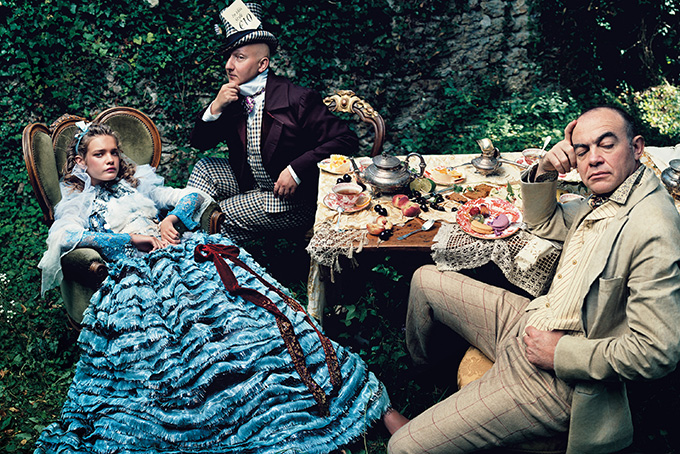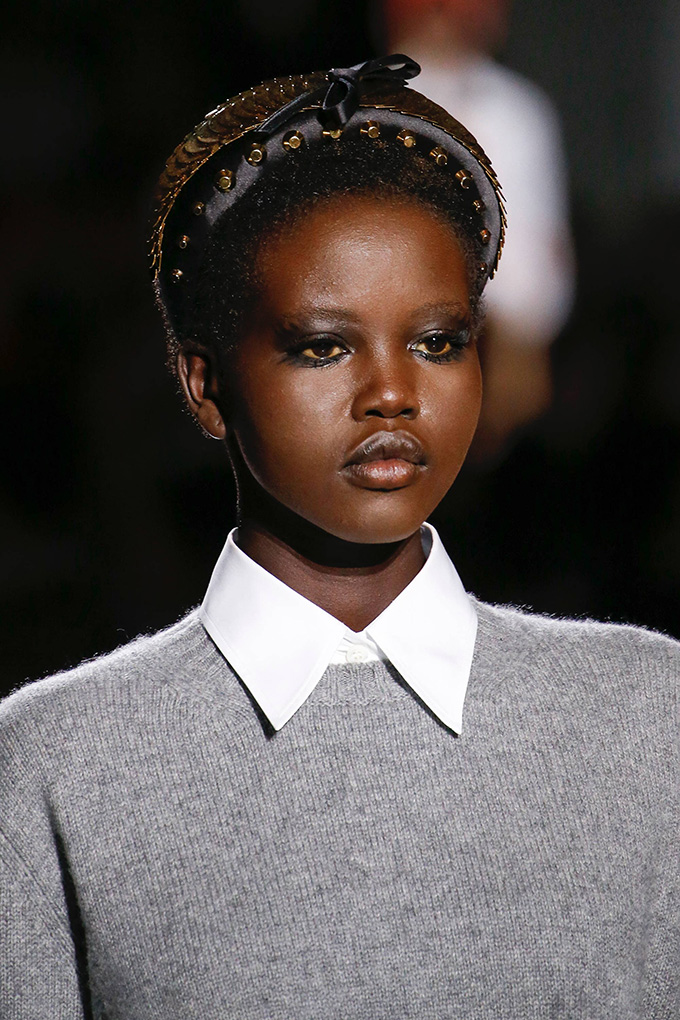A white rabbit. A pocket watch. A tea party. A grinning cat. Perhaps some painted red roses and jam tarts, or a deck of cards and a flamingo or two. Definitely a blue dress and hair band (striped stockings optional). Without mentioning either the title or author, you probably already know which book I’m talking about. These characters and visual cues are so well known that one doesn’t even need to utter the words ‘Alice’ or ‘Wonderland’ to understand what’s being referenced.

Ever since Alice first tumbled down a rabbit hole and entered the public consciousness via the release of Alice’s Adventures in Wonderland in 1865, the curious, pragmatic, sometimes snappish little girl dreamed up by Lewis Carroll (real name Charles Dodgson) has become an unusual literary emblem—and surprising visual icon. She has graced cartoons, films, fashion shoots, and surrealist paintings. She has been illustrated countless times, from illustrator John Tenniel’s original humorous line drawings featuring puffed sleeves and pinafores to artist and author Tove Jansson’s magical, rather melancholic images accompanying a Swedish edition of the book in 1966.

Now, a new exhibition at London’s Victoria & Albert Museum, Alice: Curiouser and Curiouser, puts the character in the spotlight once more. Featuring daring sets, VR experiences, and a whole host of Alice-related objects from handwritten manuscripts to stage costumes, the exhibition charts Alice’s origins, reinventions and extensive cultural reach over the past 156 years. Her influence can be felt everywhere, from the trippy reaches of 1960s psychedelia to the kitsch whimsy that coalesced around Tim Burton’s 2010 film adaptation. The wonderland she explores—containing its mad hatters, hookah-smoking caterpillars, literal floods of tears, and a murderous Queen of Hearts—is just as famous, transcending the pages to take on a life of its own.
The famous blue dress
Alice’s legacy extends in many directions, but she’s cast a particularly significant shadow over fashion. The exhibition includes a number of key works by designers including Iris van Herpen, Viktor & Rolf, and Vivienne Westwood. The latter designed a special edition cover of Carroll’s book in 2015, praising it in the accompanying introduction for its note of curiosity and mistrust of adult authority. These designers are not alone in having been inspired by the extraordinarily imaginative world created by Carroll. In fact, wonderland has been a rich territory for many generations of designers—and the fashion world, in turn, has shaped our understanding of Alice and her coterie of characters.

Now when we think of the little girl who grows, shrinks, and navigates all manner of odd encounters, we tend to imagine her in a blue dress with an Alice band. Much like Dorothy’s gingham and ruby slippers in The Wizard of Oz (1939) or Little Red Riding Hood’s, well, red hood, it’s an immediately identifiable outfit. However, the first authorised colour version of the book featured her in yellow.
Although various Alices were pictured in other hues in the late Victorian era, it wasn’t until Disney released its vivid animated version in 1951 that the Alice we think of today—complete with blonde hair, blue dress and little black shoes—crystallised. Based on drawings by Mary Blair, this version of Alice nodded to Tenniel’s original illustrations while incorporating more contemporary references. The shade was already known as Alice blue after being worn decades before by writer and eldest daughter of 26th US president Teddy Roosevelt, Alice Roosevelt Longworth, and the silhouette drew heavily from Christian Dior’s post-war ‘New Look’—complete with wide skirts and a much more defined waist.

This dress has been referenced many times by designers and photographers. In 2003, American Vogue staged a memorable shoot featuring Natalia Vodianova as Alice wearing a series of custom-designed blue garments. In each image shot by Annie Leibovitz, she was accompanied by a designer dressed as a character from wonderland (along with a few from the 1871 sequel Through the Looking-Glass). Viktor & Rolf were Tweedledum and Tweedledee. John Galliano was the Queen of Hearts. Tom Ford featured as the White Rabbit. Stephen Jones, of course, was the ideal Mad Hatter. Grace Coddington, former creative director at American Vogue, described it as an “exhausting, exhilarating” and “magical” shoot, and Vodianova brought a combination of wide-eyed innocence and sulky humour to the photos that seemed to befit a contemporary understanding of Alice.

More recently, photographer Tim Walker—whose entire back catalogue, with its interest in eccentric characters, dreamlike scenarios, and dramatic contrasts in scale, could be read as its own kind of wonderland—retold Carroll’s tale for Pirelli’s 2018 calendar. Featuring an all-Black cast, the shoot starred model Duckie Thot as Alice in baby blue and platform heels, and drag superstar RuPaul as a magnificently imperious Queen of Hearts.
https://youtu.be/WDd7G2f-V8s
Why is Alice so alluring?
Leibovitz and Walker’s photos both brilliantly illustrate the fashion appeal of Alice. They are funny, whimsical, and transporting. They allow for total immersion in make-believe and offer a vibrant canvas peopled by characters and scenes already familiar to the viewer. Carroll’s story is a flexible one. It can yield interpretations ranging from the light and frothy to dark and unnerving, depending on whether the mood is one of twee tea-sets or trippy forays into the unknown. In both contexts, though, fashion imagery often relies on a sublime sense of the ridiculous. Of course the topsy-turviness of wonderland appeals. It’s a space where nonsense reigns and transformation (that quality so readily offered by clothing) is par for the course.

By this point, you’d be hard-pressed to find a designer, photographer or stylist who hasn’t jumped down the rabbit hole or slipped through the looking glass, whether it’s via Miuccia Prada’s love of headbands, Alice Temperley’s invocations of Alice’s escapism, or Comme Des Garçons making T-shirts featuring customised versions of Tenniel’s illustrations.
For many of these creators and brands, Alice also speaks directly to the power of youthful imagination. It’s a power that those in fashion love to draw on, conjuring the familiar image of the childhood dressing up box and laying claim to the thrill and silliness of visual spectacle. To invoke Alice is to tumble into a fantasy world we all know and take pleasure in remaking anew.
This article was originally published on British Vogue.





